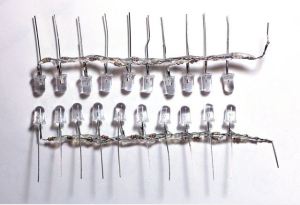
A consortium of UK universities is working on a technology that could deliver internet communications, be used as information displays and provide lighting all at the same time and all using tiny LEDs. The concept builds off of Li-Fi technology, which is the transmission of internet communications using visible light rather than radio or microwaves like current Wi-Fi, but where Li-Fi ends with internet transmission and lighting, this new technology could do so much more.
Li-Fi technology works because LED bulbs flicker on and off thousands of times per second, a rate imperceptible to the human eye. By controlling the length and timing of those flickers, digital information can be transmitted to computers, smartphones and other adapted devices almost like a digital Morse Code.
This new technology improves upon Li-Fi by going smaller, using micro-LEDs 1,000 times smaller than those typically used in Li-Fi.
Phys.org explains:
Firstly, the tiny LEDs are able to flicker on and off 1,000 times quicker than the larger LEDs this also means they can transmit data more quickly. Secondly, 1,000 micron-sized LEDs would fit into the space occupied by a single larger 1mm2 LED, with each of these tiny LEDs acting as a separate communication channel. A 1mm2 sized array of micron-sized LEDs could therefore communicate 1,000 x 1,000 (-i.e. a million) times as much information as one 1mm2 LED.
Moreover, each micron-sized LED would act as a tiny pixel. So one large LED array display (e.g. used to light a living room, a meeting room or the interior of an aircraft), could also be used as a screen displaying information at exactly the same time as providing internet communications and the overall room lighting.
"Imagine an LED array beside a motorway helping to light the road, displaying the latest traffic updates and transmitting internet information wirelessly to passengers' laptops, netbooks and smartphones. This is the kind of extraordinary, energy-saving parallelism that we believe our pioneering technology could deliver," said Professor Martin Dawson of the University of Strathclyde, the leader of the consortium.
The LEDs may eventually incorporate sensing capabilities too where the flash on your smartphone could be pointed to products in a store and all the information about them would appear on your phone.
Professor Dawson believes that the technology could start being apart of our lives within a decade.
If you want to hear more, below are a couple of videos from the researchers involved, including a TED talk delivered by Professor Hararld Haas from University of Edinburgh, another consortium member, on the potential of Li-Fi.